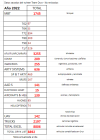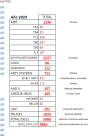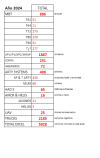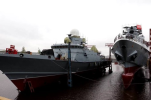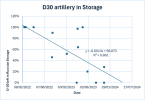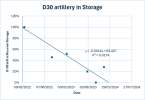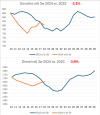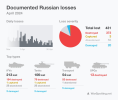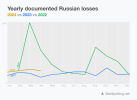Russia's 2024 budget forecasts
“Putin is financing his war today with money planned for the future,” perfectly summed up
Boris Grozovski , a Russian journalist, in November 2023. But the future may well not be the one Russia expected. The British Ministry of Defense was among the first to express skepticism about Russia's budgetary targets for 2024, in a
statement dated February 5, 2024 . He considers the achievement of these objectives “unlikely”. Indeed, if the Russian government plans an increase in spending of
26% in 2024 , to reach 36,600 billion rubles, the Russian government also plans revenue to amount to
35,065 rubles, or
a 22% increase, with with oil and gas revenue expected to increase by 25%.
In terms of spending, the 2023 trend therefore continues: compared to the period before the invasion of Ukraine, in 2024 Russia will have tripled its military spending, with the defense budget now representing
40% of government spending. State against 14 to 16% before 2022.
In terms of revenue, however, Russia has a much less clear horizon. In October 2023, Anton Siluanov, the Minister of Finance of Russia,
already announced that the use of borrowing on the domestic market would be significantly lower than expected. Chinese banks, among the last foreign banks still present on Russian territory, are in the process of drastically limiting their exposure in Russia according to
Russian media . In January 2024,
Bloomberg already reported a decline in China's financial support for Russian entities following pressure from the US State Department.
Despite
planned future tax increases , it is not certain that tax revenues will increase in 2024 in the same proportions as in 2023, which is why the Russian government is pinning much of its "hopes" on completing its 2024 budget on increasing oil revenues. But to do this, several conditions must be met, the first being a Brent price of around $85 per barrel in 2024 and a Ural price of
at least $60 per barrel .
This is the budgetary crest line on which
the Russian government will have to advance in 2024: Russia needs a high Ural barrel (beyond the Western
Cape price ) and a low ruble (to mechanically generate more rubles from the same amount paid), but not too low either, so as not to create imported inflation, in addition to the inflation already underway. As explained by
Ronald Smith , senior analyst for BCS World of Investments in Moscow, the Russian budget is especially sensitive to the price of a barrel, much more than to production volumes, the latter having remained stable compared to 2021.
Except that
revenues from Russian oil exports are not increasing for the moment compared to 2023 (the Russian budget however expects a 25% increase in these revenues this year). Added to the vagaries of the market are uncertainties about the effects of the
Ukrainian strikes on Russian refineries: in a few days, the Ukrainian strikes damaged three refineries representing
12% of Russian refining capacities. While the subject might initially seem more symbolic than anything else, Russian export figures for January 2024 indicate a decline in
export volumes . On specific oil products like gasoline and diesel, Russian exports fell by
37% and 23% respectively in January 2024. According to
Torbjörn Törnqvist , CEO of Gunvor Group, Russian production was cut by 600,000 barrels per day following the strikes in mid-March 2024. All this is happening against a backdrop of a general decline in Russia's oil revenues after the
February-March 2022 peak .
The limited reserves of the National Welfare Fund
Without a sufficient increase in oil revenues and tax revenues, Russia could very quickly be forced to dip into the NWF again. It should be remembered here that this is
normally supplemented by oil revenues . However, these fell by 24% in 2023, effectively compromising the replenishment of the fund. This does not prevent Russian Finance Minister Anton Silouanov from already announcing new cuts as he did in
October 2023 : he announced at that time that he would still remain within the NWF 6700 billion rubles at the end of 2024, compared to 13,700 billion in September 2023. Would Russia therefore keep reserves for the future? Anton Silouanov's statement only confirms the seriousness of the situation for Russia: if we rely on these figures, which are intended to be reassuring, Russia will be running out of financial reserves at the end of 2024.
To understand this, we must understand the composition of the NWF, which is not a liquid savings account from which it is possible to withdraw money with the snap of a finger. The NWF is in reality made up of a multitude of assets and securitized investments, investment accounts and other bond investments, but
90% of its “face value” is actually based on two asset classes: shares of Russian companies and liquidity (gold and foreign currency reserves). However, of everything that makes up the NWF, only the liquidity can actually be used to replenish the state budget and finance the war. And this liquidity is evaporating.
As of January 1 , 2022, the NWF totaled
13,565 billion rubles, then
10,434 billion on January 1 , 2023, and
11,965 billion on January 1 , 2024. Note that in October 2023, the fund shows well approximately
13,700 billion rubles , as indicated by Anton Siluanov. Apparently, the face value of the fund changes little, and after a drop in 2022, it finally rose again in 2023. Except that the displayed amount of these reserves is faked, especially if we look at the amount of liquidity: 8,432 billion rubles in 2022, 6132 in 2023, 5011 in 2024. To give another idea, Russia went from 113 billion dollars in reserves to 56 billion in two years (taking into account the exchange rate). A year ago, for example, the NWF still had 10 billion euros, 310 billion yuan in foreign currency and 554 tons of gold. As of January 1 , 2024, there are no euros left (nor any hard currency), there are 227 billion yuan and 358 tons of gold remaining.
This was already the case in
August 2023 , but it is even worse today. Through an accounting sleight of hand, Russia camouflages the falls in liquidity by adding shares of Russian companies in which the Russian state takes stakes: between January 2022 and August 2023, the share of shares of companies Russians in the NWF thus increased from 26 to 33% while its “face value” remained approximately unchanged. This share is
38% in January 2024. Not only are these non-liquid assets (you cannot pay for the import of components of a T-90M with shares) but above all their real valuation is completely unverifiable. and probably very largely overestimated: it is difficult to imagine, for example, that the valuation of Aeroflot has not changed since 2021, which is nevertheless what the NWF accounting suggests.
Finally, if we subtract from the total current amount of the NWF (11,965 billion) the entire liquidity (5,011 billion), we obtain 6,900 billion, or approximately the amount that Anton Silouanov announced for the end of 2024 (6,700 billion). What the Russian Finance Minister announced in October 2023 was therefore the total consumption, or close to it, of Russia's financial reserves at the end of 2024, in a context of strong uncertainties over tax revenues and revenues. oil companies this year.
Center of gravity
In terms of strategy, the effectiveness of action is based on the identification of the adversary's center of gravity, that is to say the point of his device (material or immaterial) on which our action will have the maximum impact. effects. In addition to underestimating Ukrainian resistance, Russia made the mistake of thinking that Europe's dependence on Russian gas, in the context of the catastrophic US disengagement from Afghanistan, would be our center of seriousness and that action in this direction would dissuade us from intervening and supporting Ukraine. This was the whole issue – and the failure – of the Russian gas embargo decided in the summer of 2022. Conversely, even if some have advanced the speed of the process, the West does not is not mistaken in sanctioning Russia economically and financially: like the USSR before it, Russia may not have the means to achieve its ambitions for long.
After having deprived itself of its main customers and outlets in Europe, Russia is now forced to burn its financial reserves to continue its war in Ukraine. These reserves are in the process of being exhausted: by the end of 2024, if we rely on the statements of the Russian Minister of Finance and the accounting details of his ministry's press releases, Russia will have exhausted the NWF's liquidity reserves. In a degraded economic context (inflation), without the possibility of raising debt on the financial markets, with less support from Chinese banks still present in Russia and without the prospect of sufficient oil and gas revenues, Russia could find itself in "cessation". payment” at short notice.
If Russia still has the financial capacities necessary for 2024 to finance all of the budgetary items responsible for the federal state – including the invasion of Ukraine – due to its financial reserves, the situation could change as soon as 2025. As federal government revenues (export and tax revenues) are insufficient to cover expenses (and the difference can no longer be covered by recourse to reserves), Russia could therefore quickly be forced to make budgetary choices drastic, in terms of eliminating certain expenses or increasing taxes. While it is unlikely that military spending will be affected in the short term, we could however see the reduction or elimination of many social or investment spending. It should also be remembered that the purpose of the National Welfare Fund was initially the payment of Russian pensions. Its depletion could have important social consequences for an aging Russian population. In a country where more than half of the population lives directly on state subsidies, with more than
13% poverty in 2021 (although poverty criteria are much lower than in the West) and where
62% of Russians have neither savings nor the means to pay for more than clothes and food, the long-term risk for Russia is to find itself in an economic situation identical to that which preceded the fall of the USSR.
Photo credits:
scaliger
-
Pierre-Marie Meunier
Pierre-Marie Meunier is a former military intelligence officer, and currently director of operations for a communications consultancy firm. He graduated with a double master's degree in information/communication and international relations.

